INTRODUCTION
The tomato (Solanum lycopersicum L.) is an herbaceous tropical perennial plant that originated in the South American Andes Region and is grown as an annual crop either in open fields or under protection (greenhouses), mainly in temperate climates (Costa and Heuvelink, 2018). It is one of the most important and popular vegetables globally and has broad adaptability, high yield potential and suitability for a variety of uses in both fresh and processing markets (Meena and Bahadur, 2015). China (1,040,126 ha; 61.6 Mt), India (786,000 ha; 19.3 Mt), Turkey (176,430 ha; 12.1 Mt) and the United States (130.280 ha; 12,6 Mt) were the main producers in 2018, while Colombia planted 11,227 ha with 0.52 Mt of tomato (FAO, 2020).
The grafting technique combines the shoot of a desirable cultivar (scion) onto a rootstock with desirable characteristics (Chaudhari et al., 2016). Grafting onto vigorous and resistant rootstocks has been employed not only in open fields but also under protected cultivation where grafting has positively influenced growth, yield, and quality, even in the absence of disease as the result of tolerance to abiotic stresses (Kyriacou et al., 2017; Gaion et al., 2018; Soare et al., 2018). In tomatoes, grafting was adopted to limit the effects of Fusarium wilt, to improve yield when plants are cultivated in infected soils, to induce resistance to extreme temperatures, to enhance nutrient uptake, to increase the synthesis of endogenous hormones, to improve water use, to increase flower and seed production, to enhance vegetable tolerance to drought, salinity, and flooding, and to increase yield and fruit enhancement (Khah et al., 2006).
Temperature parameters and growth must be considered when assessing environment sensitivity and external influences on grafted materials. Air temperature is the main environmental factor that regulates phenological timing and growth rates in plants because phenology dependence on temperature accelerates biological processes (Mutke et al., 2003).
Several systems have been proposed to document the development of individual plants during their life cycle in order to define and codify typical crop stages (Meier, 1997). The BBCH scale is the most widely used system to evaluate plant growth information (Biologische Bundesanstalt, Bundessortenamt und CHemische Industrie), which enables the coding of the entire development cycle or phenology of all mono- and dicotyledonous plants (Sridhar and Reddy, 2013). Plant phenology is correlated with environmental conditions (Sridhar and Reddy, 2013); temperature is a primary factor that affects the rate of plant development, and several studies on tomato growth have demonstrated its correlation with different phenological stages (Fatemi and Dehghan, 2019). The determination of heat requirements in the developing phases of plants has been expressed as Growing Degree Days (GDD) or Heat Units (García-Rojas and Pire, 2008; Cuong and Tanaka, 2019). There is a relation between average air temperature and maximum yields. The timing of phenological stages in a crop can be predicted with a historical series of temperature for a specific location (Gadioli et al., 2000). Consequently, Growing Degree Days or Heat Units estimate plant growth and development and help growers schedule activities (Lucas et al., 2012; Fraisse and Paula-Moraes, 2018; Zhou and Wang, 2018; Cuong and Tanaka, 2019; Fatemi and Dehghan, 2019). The relationship between the rate of development and temperature is key for calculating GDD because the growth rate from planting to maturity for a specific crop is strongly dependent on this environmental variable (Fatemi and Dehghan, 2019). Different studies have indicated different maximum thresholds. Heuvelink et al. (2018) stated that the potential tomato yield is reduced at temperatures above 26°C. Zalom and Wilson (1999) indicated that, when temperatures exceeded 30°C, tomato plant development was delayed. Nicola et al. (2009) reported that temperatures above 35°C cause abortion of tomato flowers, and Moreno et al. (2016) indicated a high threshold temperature of 30°C for tomato growth, and a base temperature of 10°C is considered. However, Heuvelink et al. (2018) observed that tomato plants and fruits suffer physiological injury under low non-freezing temperatures, below 12°C, and that the base temperature for node emission and plastochron determination in some tomato species varied from 4.5 to 14.8°C (Zeist et al., 2018). The aim of this study was to determine the different phenological phases and yield of tomato plants grafted on different rootstock×scion combinations according to the BBCH scale in the high-Andean region in Colombia.
MATERIALS AND METHODS
This experiment was conducted under plastic house conditions on the El Socorro farm, El Santuario, Antioquia, Colombia (6°6'55.8'' N and 75°13'10.15'' W, 2,251 m a.s.l.) in the high-Andean region. The soil used in the experiment was a sandy loam-clay-sandy textural class, pH (5.0), electric conductivity (0.06 dS m-1), organic matter (5.8%), phosphorus (66 mg kg-1 soil), sulfur (53.2 mg kg-1 soil), Ca (10.6 cmolc kg-1), Mg (3.0 cmolc kg-1 ), K (2.47 cmolc kg-1), ECEC (16.5 cmolc kg-1), Fe (74 mg kg-1), Mn (9 mg kg-1), Cu (9 mg kg-1), Zn (5 mg kg-1) and B (0.2 mg kg-1).
A randomized complete block design was used, with four repetitions and four treatments. The treatments consisted of a single commercial tomato scion grafted on different rootstock combinations: vigor rootstock, resistant rootstock, self-grafting, and non-grafted plants. Each experiment plot had four rows, each row with eight plants, for a total of 32 plants. Four central plants were used for the experiment unit. The genotype used as the scion was tomato cultivar Libertador, and the rootstocks were the two cultivars Olimpo, with vigor characteristics, and ‘Armada’, resistant to Ralstonia solanacearum and Fusarium oxysporum f. sp. radicis-lycopersici. Cv. Libertador is a chonto-type tomato with indeterminate growth, short internodes, round fruits with weights between 150-200 g, and a life cycle of 195 d. The grafting methods used the tongue approach described by Lee et al. (2010). This method consists of removing the growing point of the rootstocks and making a second cut down on the rootstock and an upward cut on the scion, providing a thin tongue on each piece. After the graft has been done, clips are used to fix the graft position. Grafted and non-grafted plants were transplanted and kept in a plastic house on 04/29/2019, with the third leaf on the main shoot folded, corresponding to stage 103 according to BBCH scale (Feller et al., 1997). As part of the management, the first lateral stem could grow below the first inflorescence, with two stems per plant, for a density of 40,400 stems/ha (1.1 m between rows and 0.45 m between plants). Tutoring with galvanized wire lines located at 2.2 m was used, from which both stems of each plant were tied with synthetic fiber threads. At 15 d after transplantation, the shoots emitted by the rootstock were pruned, and, at the 7th and 12th weeks, pruning was carried out, eliminating the lower leaves. Irrigation was done with drip irrigation, applying 243.2 L of water per plant during the life cycle (1.42 L d-1). The growth of the tomato plants was allowed until the emission of nine fruit clusters on the main stem (1) and seven fruit clusters on the lateral stem (2), for a total of 16 fruit clusters emitted throughout the life cycle (1C1, 1C2, 2C3, 1C4, …, 2C15, 1C16). In each plant, the two-stem axis was selected for a daily evaluation of the percentage of sprouted buds and number of opened flowers. Full bloom was defined as when 70% of the flowers had opened. The clusters on each tomato plant were numbered in order of occurrence according to the BBCH scale (Feller et al., 1997) for the principal growth stage 5 (50): Inflorescence emergence; growth stage 6 (60): Flowering and growth stage 7 (70): Development of fruit.
The minimum, mean, and maximum temperatures (°C) and relative humidity (%) were monitored with a portable thermohydrometer “Extech RHT20” from 04/29/2019 to 10/25/2019.
According to Riaño et al. (2005), two methods for estimating growing degree days: the first one, when the maximum temperature exceeds the maximum threshold with the following equation (1):
and the second one, when maximum temperature was belowthe maximum threshold, the equation (2) was used:
where, GDD is the growing degree days, T max and T min are the daily maximum and minimum temperatures, T base is the base temperature, L s and L i are the high and low temperature threshold, and α = (T max - T min )/2. The base temperature was 10°C (Moreno et al., 2016), and the high threshold temperature was 35°C (Nicola et al., 2009).
The accumulated growing degree days was calculated by taking the sum of growing degree days as in equation (3) proposed by Cuong and Tanaka (2019) and Zeist et al. (2018):
where, i is the indicated day, n was a specific period (day) of plant growth during cultivation; and GDD i was the heat unit on i th day (°Cd).
The internode number and length emitted between each cluster were measured until the emission of ninth fruit clusters on the main stem and seventh fruit clusters on the secondary stem, for a total of 16 fruit clusters. Other evaluated variables were rootstock and scion diameter (cm), compatibility index, ratio between rootstock and scion diameters, plant height (cm), and numbers of flowers and fruits set per fruit cluster. The yield (kg m-2) was the total accumulated weight of fruits produced in the entire life cycle of the tomato plants per square meter.
The variances between the treatments were analyzed with one-way ANOVA and multiple comparisons with Tukey's HSD (honestly significant difference) test at 5% probability, using the R project “Agricolae” package (R Core Team, 2017).
RESULTS AND DISCUSSION
The average air temperature was 19.8°C, and the absolute minimum and maximum temperatures were 10.1 and 43.4°C; on the other hand, the average relative humidity was 77%, with a maximum and minimum of 89 and 65%. The maximum air temperature was above the maximum threshold (35°C) in the middle of the day during the experiment period, while the minimum temperature was always above the base temperature for the tomato crop (10°C) (Fig. 1).
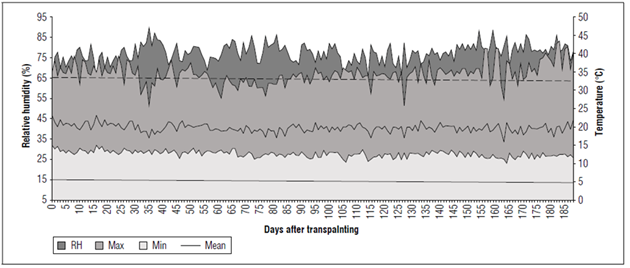
Figure 1. Relative humidity (RH) and daily maximum (Max), minimum (Min) and mean (Mean) temperatures in the plastic house from 04/23/2019 to 10/25/2019. Solid and dotted line are the lower and superior temperature threshold for tomato growth.
In total, 2,567 heat units (°Cd) were required to complete the life cycle, with values between 9 to 20°Cd, with an average value of 13.57°Cd were the values of the growing degree days accumulated required for tomato under plastic house conditions in the high Andean region in Colombia (Fig. 2).
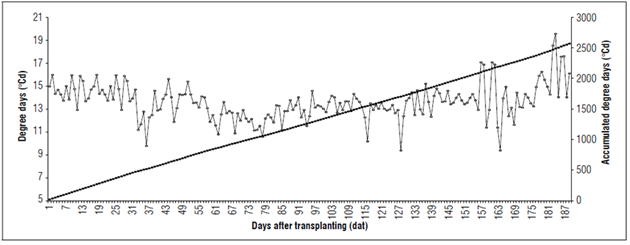
Figure 2. Accumulated growing degree days (●) and daily growing degree days (○) in the plastic house from 04/23/2019 to 10/25/2019.
In the stages inflorescence emergence 5 (50) and development of fruit 7 (70), there were no statistical differences, except for the 510, 701 and 712 stages. The main significant differences were in the flowering and growth stage 6 (60) (Fig. 3). Significant differences were observed for the accumulated degree days between some of the growth sub-stages (01 to 16) within each main growth stage (inflorescence emergence 5, flowering and growth stage 6 and development of fruit 7). There were a maximum of 119°Cd in 712 and a minimum of 25°Cd in the 601 stage, considering the average of each day (13.57°Cd), the maximum difference in thermal time observed, it would correspond to 8.7 d, and the minimum of 1.84 d, but at specific and intermediate moments in the development of the tomato crop. At the end of the cycle, there were no significant differences, and 2,576°Cd were needed for all treatments, which means, the different combinations did not significantly alter the phenological cycle of the tomato genotype used as the scion (Fig. 3).
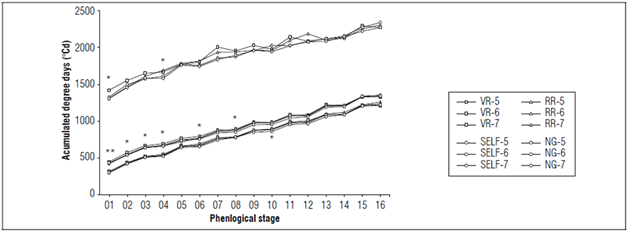
Figure 3 Accumulated growing degree days for the inflorescence emergence (5), flowering and growth stage (6) and development of fruit (7) tomato phenological stages for the different scion×rootstock combinations: vigor rootstock (VR), resistance rootstock (RR), and self-grafted (SELF) and non-grafted plants (NG). Asterisks represent the difference between treatments with ANOVA at 1* and 5%** probability.
For flowering, Khah et al. (2006) observed that, in greenhouse cultivations, inflorescence emergence began earlier in the self-rooted plant, so they assumed that grafting caused stress and delayed flowering formation, which differed from the results observed in this study, where the flowering time was not altered by grafting likely it not cause any stress in this experiment or the stress may be due to compatibility between scion×rootstock interaction.
Although various studies, such as those carried out by Mendoza-Pérez et al. (2018) and Thwe et al. (2020), have reported different thermal time values (1,762 and 2,491°Cd) for tomatoes, according to Fatemi and Dehghan (2019), the heat required by a particular organism to complete its development stages is invariable, and determining the length of the growing season in each region has a significant effect on selecting suitable crops, variety, and planting time, as well as other agronomic decisions. In this experiment, grafting did not modify the required heat to complete the production cycle, as reported Mendoza-Pérez et al. (2018) who proposed that the accumulated degree days for tomatoes was 1,762, independent of the number of stems per plant.
On the other hand, the order of emission of each cluster in the inflorescence (5) and flowering (6) stages occurs from the main stem, with the formation of the first and second flower clusters; while the following clusters develop alternately between the secondary and the main stem, in the following order: clusters 3, 5, 7, 9, 11, 13 and 15 in the secondary stem and 4, 6, 8, 10, 12, 14 and 16 on the main stem (Fig. 3).
There were no significant differences in the different scion×rootstock combinations for the thermal time needed to total harvest for each fruit cluster (P>0.05). However, differences were observed in the degree days accumulated between the beginning and end of the fruit harvest in each cluster for all treatments (Fig. 4).
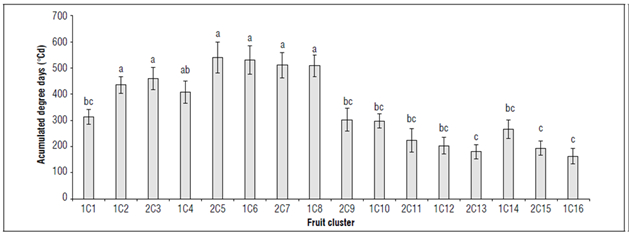
Figure 4. Accumulated growing degree days needed to fully harvest each tomato fruit cluster (C1 to C16) developed on the mean stem (1C) and lateral stem (2C). Means followed by the different letter,indicate significant differences according to Tukey’s test (P≤0.05). Bars represent mean±standard error.
As shown in figure 4, the thermal time necessary to fully harvest every fruit cluster from the second to the eighth cluster did not show significant differences, but, from the 9th to 16th fruit cluster, the accumulated thermal time was significantly less (P=0.000156). The first clusters require higher heat units to achieve full fruit development, while the clusters at the end of the cycle had accelerated development, requiring lower heat units.
Similar to the thermal time, differences for the number and length of internodes and distance between fruit cluster in some scion×rootstock combinations were observed between some of the growth sub-stages (01 to 16) (Fig. 5). The number of internodes emitted by the tomato plants until the formation of the first inflorescence was between 6.5 and 7.5 for the non-grafted and vigor rootstock treatment, while, from the second until the 16th cluster, a new inflorescence was developed every three internodes (Fig. 5).
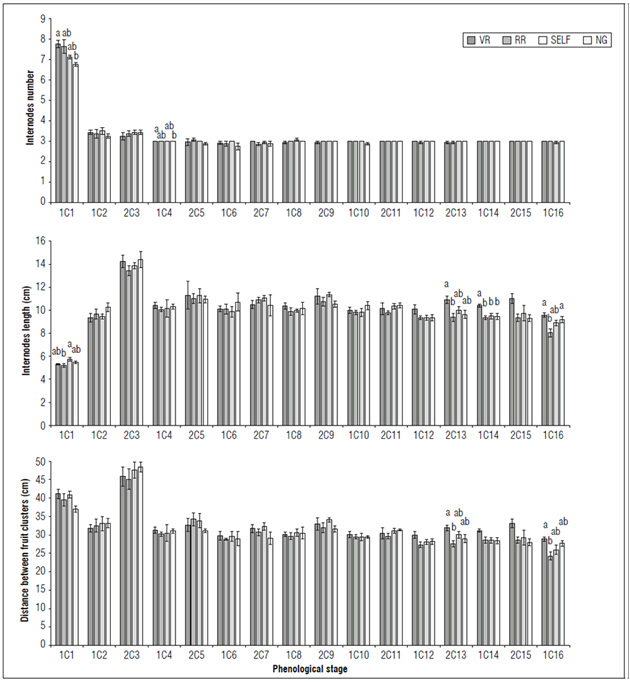
Figure 5. Number and length of internodes and distance between fruit cluster in some scion×rootstock combinations. Means followed by the different letter,indicate significant differences according to Tukey’s HSD test (P≤0.05). Bars represent mean±standard error.
Differences detected for some growth flows at the final time of development were observed for the internode length and the distance between inflorescence clusters. The greatest internode length was observed in the main stem when the first cluster was formed (2C3); however, at the end of the cycle, the plant height did not show significant differences (Tab. 1), as reported by Khah et al. (2006) who found some statistical differences during growth in plant height; however, at the end of the cycle, it was not significantly affected by grafting.
Table 1. Variables assessed in different scion × rootstock tomato combinations (VR, RR, SELF and NG)1.
| Treatment | Rootstock (R) diameter (cm) | Scion (S) diameter (cm) | Compatibility Index (R/S) | Plant height (cm) |
|---|---|---|---|---|
| VR | 1.39 ± 0.04 a | 1.54 ± 0.05 a | 0.90 ± 0.01 a | 283.7 ± 5.2 a |
| RR | 1.34 ± 0.06 a | 1.31 ± 0.06 a | 1.02 ± 0.02 b | 265.3 ± 4.9 a |
| SELF | 1.21 ± 0.07 a | 1.24 ± 0.09 a | 0.98 ± 0.03 b | 257.6 ± 18.1 a |
| NG | 1.43 ± 0.06 a | 1.47 ± 0.09 a | 0.98 ± 0.02 b | 270.7 ± 18.1 a |
| P value | 0.111 | 0.065 | 0.023 | 0.347 |
| Treatment | # Flowers/plant | Fruit set (%) | Fruit yield | |
| (kg m-2) | ||||
| VR | 108.0 ± 3.53 a | 92.68 ± 4.6 a | 21.63 ± 2.58 a | |
| RR | 108.7 ± 1.49 a | 83.7 ± 4.7 b | 16.78 ± 2.30 b | |
| SELF | 107.4 ± 1.11 a | 83.3 ± 3.1 b | 17.71 ± 2.14 b | |
| NG | 108.5 ± 3.62 a | 82.3 ± 3.4 b | 17.93 ± 2.16 b | |
| P value | 0.99300 | 0.08190 | 0.000142 | |
1 vigor rootstock (VR), resistance rootstock (RR), self-grafting (SELF) and non-grafted plants (NG). Means followed by the different letter, indicate significant differences according to Tukey’s test (P≤0.05). Bars represent mean±standard error.
Table 1 shows the values of the stem diameter of the rootstock and scion separately measured below and above the scion/rootstock union. This variable did not present a significant difference; nevertheless, for the rootstock/scion ratio, statistical differences were observed. The use of a vigor rootstock generated a ratio less than one, indicating that the diameter of the scion was larger, while the other combinations registered ratios close to one, suggesting compatibility. The similar diameter of the scion and rootstock could have resulted from similar stem diameters at grafting, and this, in turn, is a type of selection by vigor between both plants.
The scion×rootstock combination with the highest yield (21.63 kg m-2) was the vigor rootstock, which differed significantly (22% more fruit) from the resistant rootstock (16.78 kg m-2), self-grafted (17.71 kg m-2) and non-grafted (17.93 kg m-2) tomato plants, which did not present statistical differences (Tab. 1). The fruit yield observed in the ‘Libertador’/’Vigor’ combination was higher than the local national average (9.6 kg m-2) under greenhouse conditions (FAO, 2020). In the case of non-grafted plants, a similar result was found by Mendoza-Pérez et al. (2018) with yields of 18 kg m-2 for tomato crops pruned to two stems, at a similar altitude (2,244 m). The superior fruit yield observed on the vigor rootstock treatment was related to the fact that this combination allowed a higher fruit set than the other combinations, especially for “first quality” tomatoes (unpublished data). Similar results were documented by Sora et al. (2019), who indicated an increase of more than 80% of “extra” and “first quality” fruits in grafted plants, as compared to non-grafted plants. No significant differences were observed for the number of flowers between the treatments, similar to that observed by Khah et al. (2006), where the number of flowers emitted for all grafting treatments and for the non-grafted plants was not significant.
The increased performance with the use of rootstock vigor validates the findings of Kyriacou et al. (2017); Soare et al. (2018) and Zeist et al. (2017), who indicated that grafting onto vigorous rootstocks has been employed in open fields and under protected cultivation, where grafting positively influenced growth, yield and fruit. Similar results were found by Khah et al. (2006) in grafted tomato plants, which were more vigorous than the non-grafted plants in a greenhouse and produced between 12.8 to 32.5 % more fruit yield than non-grafted ones. On the other hand, Soe et al. (2018) reported that marketable tomato yields were 66 % higher in grafted tomatoes than in non-grafted tomatoes. The use of grafted tomato plants is a suitable method with a positive and improved effect on plant growth, development, and fruit yield, obtaining higher tomato yield and quality.















